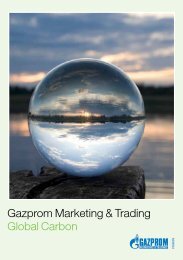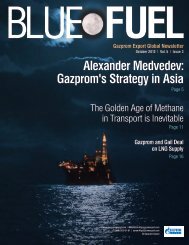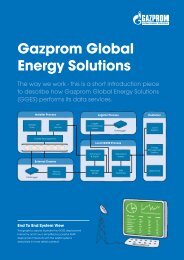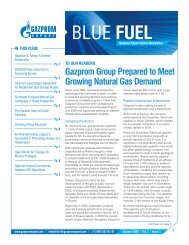GM&T Magazine Issue 2 - Gazprom Marketing & Trading
GM&T Magazine Issue 2 - Gazprom Marketing & Trading
GM&T Magazine Issue 2 - Gazprom Marketing & Trading
You also want an ePaper? Increase the reach of your titles
YUMPU automatically turns print PDFs into web optimized ePapers that Google loves.
NORD STREAM<br />
NORD STREAM<br />
More than a thousand kilometres long, the<br />
Nord Stream Pipeline through the Baltic Sea<br />
will bring large volumes of much-needed gas<br />
to the European Union (EU), directly from the<br />
vast reserves in Russia.<br />
The 1,223 kilometre-long pipeline has<br />
become a priority because domestic supplies<br />
of gas in Europe are dwindling and demand<br />
is rising. Natural gas already meets about a<br />
quarter of Europe’s primary energy needs.<br />
But the European Commission (EC) predicts<br />
a growing gas import gap of about 200 billion<br />
cubic metres (bcm) a year by 2025, resulting<br />
from rising demand at a time of declining<br />
production. This is why the European Union<br />
(EU) has made the development of a new gas<br />
supply infrastructure a priority.<br />
Nord Stream will provide about 55 bcm of<br />
gas annually when its two parallel pipelines<br />
become fully operational by 2012. That<br />
Full<br />
stream<br />
Europe needs new sources of natural gas to maintain economic<br />
growth and meet growing energy demand – which is where the<br />
Nord Stream Pipeline comes in<br />
is enough to fill about a quarter of Europe’s<br />
natural-gas import gap by 2025, and enough<br />
to satisfy the gas demand of about 26 million<br />
European households.<br />
By the end of 2011, the first of the two<br />
parallel pipelines will already supply 27.5 bcm<br />
a year. From its landing point in Lubmin, near<br />
Greifswald on the northern coast of Germany,<br />
gas will be piped via the European gas<br />
network to where it’s needed most – Germany,<br />
Denmark, the UK, the Netherlands, Belgium,<br />
France, and the Czech Republic.<br />
While Nord Stream is not the only importgas<br />
pipeline planned for Europe, it is currently<br />
one of the most advanced. No other major<br />
new pipeline with a capacity of over 10 bcm is<br />
expected to be operational before 2015.<br />
Recognising the importance of Nord Stream<br />
to the overall European energy mix, the<br />
European Parliament and Council designated<br />
67.4 billion<br />
ahead<br />
Pipe being delivered to Nord Stream<br />
in Mukran, Germany<br />
THE CURRENT ESTIMATED<br />
TOTAL COST IN EUROS<br />
OF BUILDING THE NORD<br />
STREAM PIPELINE<br />
the EU is taking crucial steps<br />
towards securing energy<br />
supplies for the future<br />
Andris Piebalgs<br />
EU Energy Commissioner<br />
1,223<br />
THE LENGTH OF THE<br />
NORD STREAM PIPELINE<br />
IN KILOMETRES<br />
the pipeline as a project of “European interest”<br />
in 2000 under its Trans-European Energy<br />
Networks guidelines. In July 2009, EU Energy<br />
Commissioner Andris Piebalgs reaffirmed<br />
the importance of new gas routes for Europe,<br />
stating: “The European Commission has<br />
always been favourable to Nord Stream. With<br />
the progress being made in this project… the<br />
EU is taking crucial steps towards securing<br />
energy supplies for the future.”<br />
The current estimate for the total cost of<br />
building the Nord Stream Pipeline is 7.4 billion<br />
euros. It will be constructed at no cost to the<br />
European taxpayer. In fact, Nord Stream’s<br />
shareholders are investing 30 per cent of the<br />
total budget, while the remaining amount<br />
will be financed externally through limited<br />
recourse finance, including banks and export<br />
credit agencies. Contracts for all finance for<br />
the first phase of the project are expected to<br />
be concluded by the end of 2009.<br />
The Baltic Sea, surrounded by nine<br />
countries, is a unique ecosystem. It is used<br />
commercially for shipping, tourism, fishing<br />
and production of raw materials by all of the<br />
surrounding countries. Cooperation of all nine<br />
countries is of great importance in providing a<br />
balance between sustainable commercial use<br />
and safeguarding the Baltic Sea’s ecosystem.<br />
The Nord Stream Pipeline enters the sea<br />
near Vyborg in Russia and reaches land in<br />
Germany. As the pipeline passes through the<br />
territorial waters or the Exclusive Economic<br />
Zones of Russia, Finland, Sweden, Denmark<br />
and Germany, permits to build and operate<br />
the pipeline must be obtained from each of<br />
these countries. Because other countries<br />
around the Baltic Sea could also be affected,<br />
the international consultations include Poland,<br />
Lithuania, Latvia and Estonia.<br />
On 20 October, Nord Stream received the<br />
approval from Denmark’s Energy Authority to<br />
construct the pipeline in Danish waters. On<br />
5 November, Sweden and Finland granted<br />
permits to utilise their Exclusive Economic<br />
Zones (EEZ) for the pipeline.<br />
55<br />
THE<br />
NUMBER OF<br />
BILLION CUBIC<br />
METRES OF GAS<br />
THAT THE PIPELINE<br />
WILL SUPPLY<br />
ANNUALLY<br />
7
















